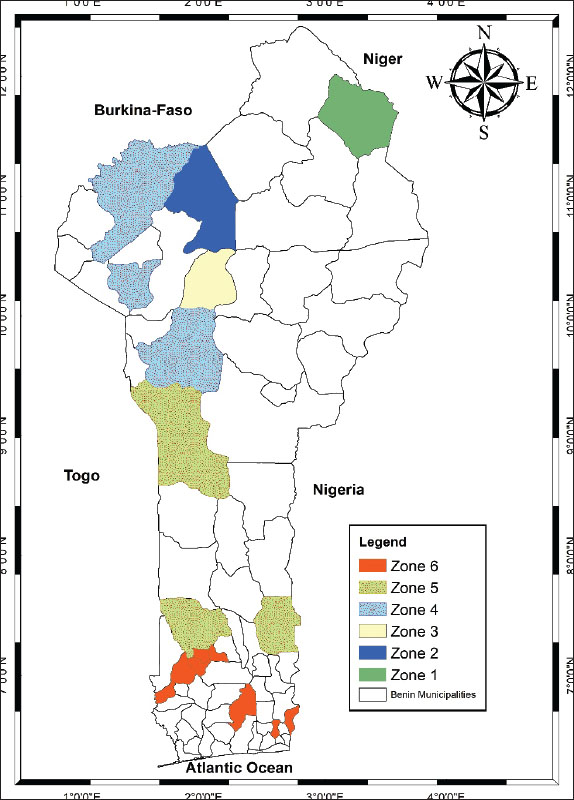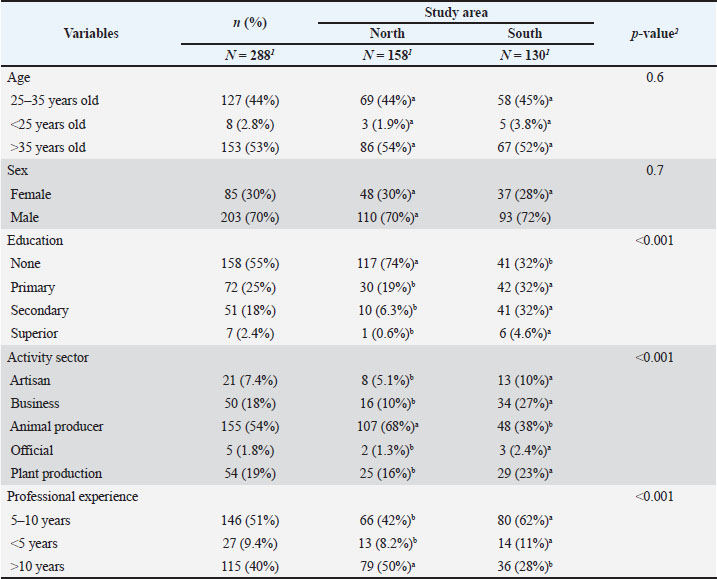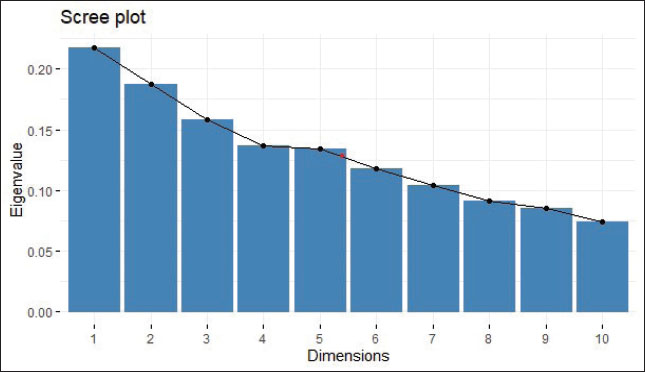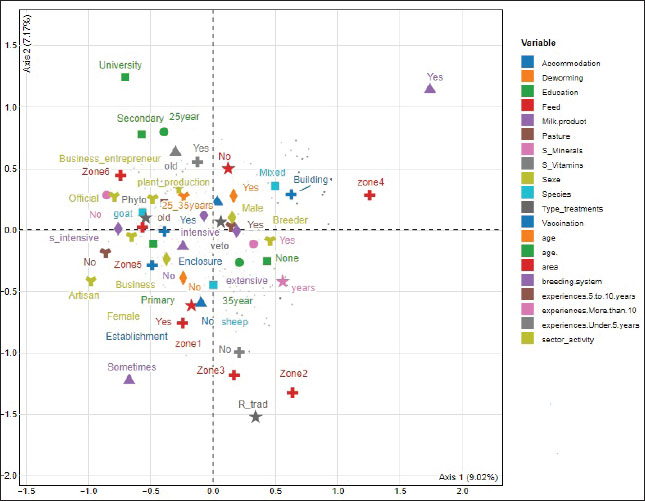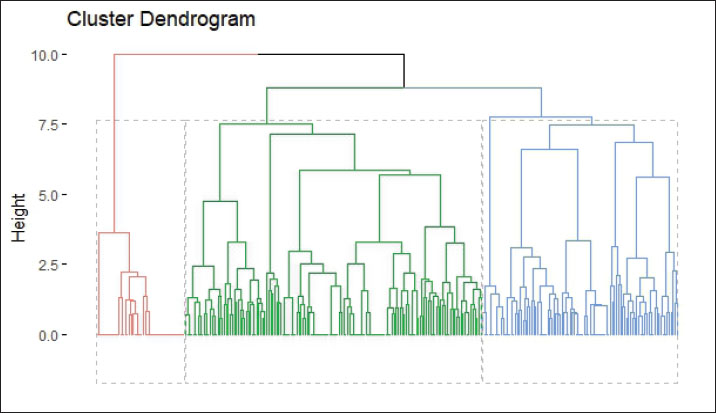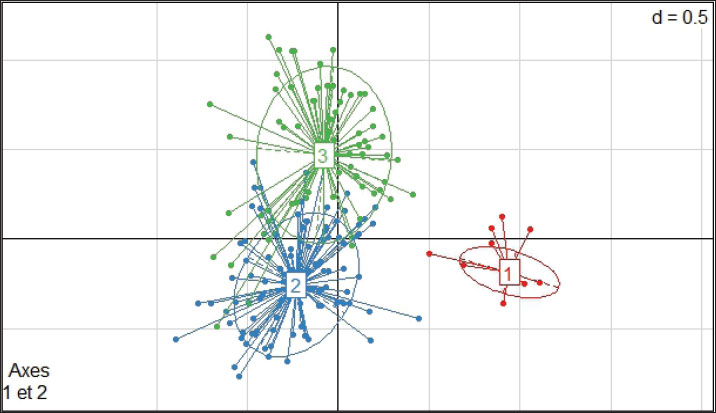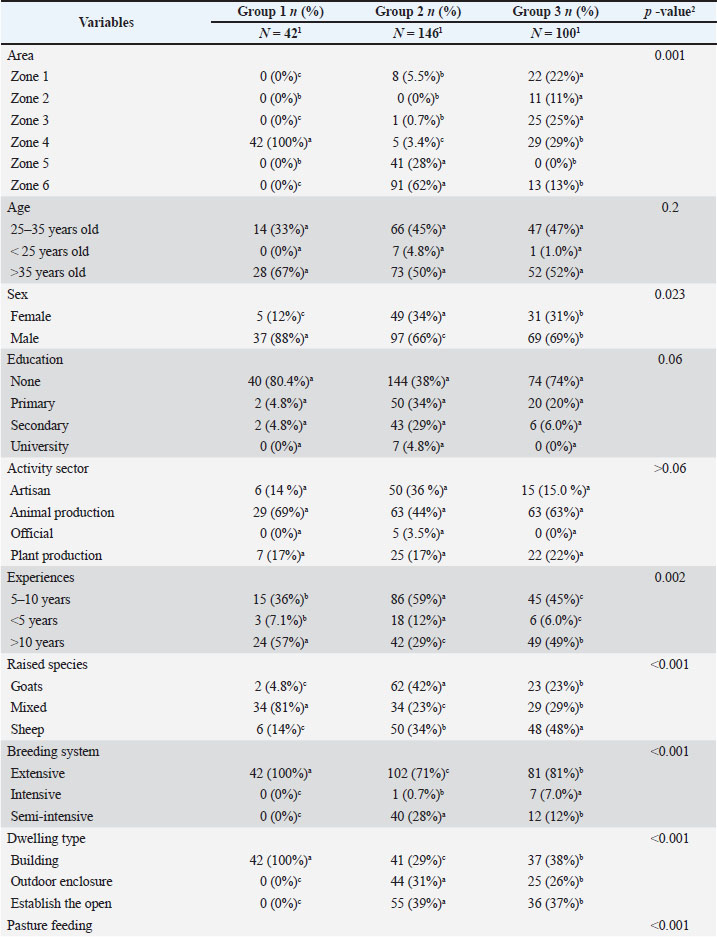
| Research Article | ||
Open Vet. J.. 2025; 15(9): 4650-4663 Open Veterinary Journal, (2025), Vol. 15(9): 4650-4663 Research Article Typology of small ruminant production systems and dairy farm characterization in BeninYvette Adje1, Philippe Sessou1*, Aretas Tonouhewa1, Justin Adinci1, Paulin Azokpota2, Lamine Baba-Moussa3 and Souaïbou Farougou11Research Unit on Communicable Diseases, Polytechnic School of Abomey-Calavi, University of Abomey-Calavi, Abomey-Calavi, Benin 2Laboratory of Food Science and Technology, University of Abomey-Calavi, Jericho-Cotonou, Benin 3Laboratory of Biochemistry and Molecular Typing in Microbiology, Department of Biochemistry and Cell Biology, Faculty of Science and Technology, University of Abomey-Calavi, Abomey-Calavi, Benin *Corresponding Author: Philippe Sessou. Research Unit on Communicable Diseases, Polytechnic School of Abomey-Calavi, University of Abomey-Calavi, Abomey-Calavi, Benin. Email: sessouphilippe [at] yahoo.fr Submitted: 20/07/2025 Revised: 03/07/2025 Accepted: 12/09/2025 Published: 30/09/2025 © 2025 Open Veterinary Journal
AbstractBackground: Livestock farming constitutes a principal component of the economic sector in West Africa, particularly within rural communities. Aim: A cross-sectional survey was performed in six agroecological zones to advance the development of small ruminant farming in Benin and elevate producers’ incomes, aiming at categorizing the diverse forms of small ruminant farming and uncovering the essential factors that differentiate them. Methods: A total of 288 farmers from various regions were surveyed using a semistructured questionnaire implemented on KoboCollect. Data were then analyzed using multiple correspondence analysis (MCA) and ascending hierarchical classification (AHC). Results: Approximately 70% of the farmers interviewed were men, compared with 30% of the women. More than half (55%) had received no formal education, whereas the majority (91%) were fairly experienced and had been raising small ruminants for at least 5 years. Three farming systems were adopted for sheep and goat rearing: extensive, semi-intensive, and intensive, practiced by 78%, 18%, and 2.8% of farmers, respectively. A number of diseases were frequently noted, primarily respiratory illnesses such as pneumonia (67%), abscesses (48%), and dermatitis (33%). The MCA identified three clusters: type 1, which is composed of dairy farms and accounts for 14.5% of the total number of farmers; type 2, which accounts for 50% of the total number of farmers and is composed of meat producers with good husbandry practices and management of health constraints; and type 3, which accounts for 37.7% of the total number of farmers and is composed of meat producers with acceptable husbandry practices but poor management of health constraints. Conclusion: The milk-producing farms adopted good feeding practices and regularly vaccinated and dewormed their livestock. In addition to meat production, sheep and goats can be used for milk production in Benin if good husbandry practices are promoted and adopted in flock management. Keywords: Typology, Sheep, Goats, Milk, Benin. IntroductionLivestock farming constitutes a principal component of the economic sector in West Africa, particularly within rural communities. It is a vital agricultural element, contributing approximately 44% to the sub-region’s agricultural GDP (Valerio et al., 2020; Eeswaran et al., 2022). In 2022, the population of small ruminants in the 16 countries of West Africa was estimated to be 169.81 million sheep and 224.27 million goats. These figures underscore the benefits of producing these animal species, particularly regarding their contribution to food security and poverty alleviation. In Benin, small ruminants are mainly reared within various farming systems across the country’s eight agroecological zones. These animals constitute a significant source of supplementary income and are the second most important animal species, with an estimated population of approximately 2,295,522 sheep and 2,362,001 goats (Dossa et al., 2008; RNA, 2021). These animals are appropriately adapted to various agroecological settings and represent an important source of income, animal protein, and capital for households (Dossa et al., 2008; Zanou et al., 2023). To improve farmers’ incomes and the country’s food security, the Benin government has implemented since 2016 several projects to promote ruminant farming, including sheep and goat farming. For the optimal impact of the various interventions, a thorough understanding of the different farming systems and their determinants is required. Even with their evident importance, the small ruminant production systems in Benin display significant heterogeneity, indicative of the diverse socio-economic, environmental, and cultural settings found throughout the country (Adamou et al., 2024). Variability can be observed in herd management practices, feeding approaches, production targets, and intensification levels (Azando et al., 2022; Dimon et al., 2022; Edoh et al., 2023) . Livestock typology is a classification approach that categorizes farms or livestock production systems based on specific criteria. These criteria are diverse and may involve the mode of production, animal breeds, production goals, husbandry practices, and farmers’ socio-economic characteristics. Its primary goal is to break down the complexities of reality to improve the comprehension of the different livestock farming methods employed in a particular area (Walder et al., 2012; Huber et al., 2024). This classification method has been used in various contexts to explore and describe the diversity of farming systems and their structural and socio-economic characteristics to develop evidence-based recommendations for their improvement (Soini et al., 2012; Seidou et al., 2016; Zoma-Traoré et al., 2020; Valverde Lucio et al., 2021; Zinsou et al., 2024). An in-depth understanding of livestock typology is crucial for the design and implementation of relevant and effective livestock development policies that respond to each system’s specific challenges and promote sustainable production. Within this framework, this article proposes a characterization of the different types of small ruminant livestock farming in Benin, identifying the key factors that distinguish them and discussing the implications of this typology for improving the sector’s productivity and resilience. Materials and MethodsStudy areaThis study was conducted in Benin, a West African country characterized by great climatic, soil, and plant diversity. It is in the Gulf of Guinea between Togo and Nigeria. This study covered 17 municipalities in six of the country’s eight agroecological zones. The municipality of Malanville is located in the extreme north zone (Zone 1), which is characterized by the northern boundary of the country, and the presence of the Niger River and its tributaries. The climate is Sudano-Sahelian, with a long dry and rainy season. Temperatures are often excessive, reaching 40°C in the shade during the dry season. The vegetation is shrubby to thorny Savannah type, and the soil is ferruginous. Food crops and vegetables, such as onions and tomatoes, are widely grown in this region. The municipality of Kerou is located in the cotton-growing zone of northern Benin (Zone 2) and, like Zone 1, is marked by the presence of tributaries of the Niger River. The climate is of the Sudano-Sahelian type, with dry and rainy seasons, coupled with vegetation that is largely dominated by Savannah and continuous herbaceous cover. Cotton is the dominant crop in this region. The municipality of Pehunco is part of the Sud-Borgou food-growing zone (Zone 3) and is characterized by a high availability of agricultural land and a humid Sudanian climate marked by a rainy season from April to September and a dry season lasting almost 5 months (Monkotan et al., 2023). The area is ideal for growing food crops such as maize, cowpeas, millet, and sorghum. The communes of Djougou, Natitingou, and Tanguieta belong to the West-Atakora zone (Zone 4), which is characterized by the presence of the Atakora mountain range, giving it a high-altitude climate with cooler temperatures and more abundant rainfall than other regions. The main river is the Pendjari, with its tributaries watering the Pendjari National Park to the north. The municipalities of Bassila, Djidja, and Ketou are located in Zone 5 of the central cotton zone. This is the largest agroecological zone, covering the entire Collines department and parts of the Borgou, Donga, Couffo, Plateau, and Zou departments (Abou Chabi and Tovignan, 2023). The climate is South Sudanian, with a rainy season alternating with a dry season. The Ouémé River and its tributaries irrigate this zone, where cotton is also an important crop, in addition to arable crops such as maize and yams. Finally, the municipalities of Abomey, Agbangnizou, Akpro-Misserete, Bohicon, Djacotomey, Ifangni, Klouekanme, and Zè are located in the Terres de Barre zone (Zone 6), which covers the departments of Atlantique, Couffo, Mono, Ouémé, and Plateau (Monkotan et al., 2023). Zone 6 is characterized by a subequatorial climate with two rainy seasons and two dry seasons and the presence of ferralitic soils known as "terres de barre." The vegetation is of the dense shrub thicket type, dominated by oil palm and grasses, with a few forest remnants. The hydrography is marked by the Mono, Couffo, and Ouémé rivers, while major demographic pressure coupled with growing urbanization has been observed in the area in recent years. The distribution of the different agroecological zones in Benin is shown in the Figure 1 (Abou Chabi and Tovignan, 2023). Sampling and collection of dataTo collect data from small ruminant breeders in various communes targeted by the study, a cross-sectional survey was conducted among goat and sheep breeders aged over 18 who had been practicing in the localities for at least 1 year. The sample size was calculated using Cochran’s formula (Cochran, 1977) as follows:
Fig. 1. Mapping of the study area. n=Z2 *P*(1−p)/e2. With an expected proportion (p) of farmers engaged in dairy production set at 50%, a margin of error (e) set at 5%, and a confidence interval (Z) of 90%. The minimum sample size was estimated at n=271 farmers. However, 288 people were surveyed. The data collection tool used was a specially designed semi-structured questionnaire divided into three sections: (1) socio-demographic characteristics of farmers, (2) animal management practices, and (3) production objectives. The form was then digitized on KoboToolbox and administered to the farmers via smartphones by interviewers trained in the use of the questionnaire beforehand. The farms were located based on consultation with veterinary service officers in each commune, while enrollment for the study was based on random sampling, and each respondent was interviewed based on informed consent. Data analysisThe collected data were exported to a Microsoft Excel workbook and recorded before statistical analysis using R Software 4.0.5. First, a descriptive analysis was conducted to calculate the proportions of the modalities of the different variables of interest. Next, 17 qualitative variables describing the sociodemographic characteristics and breeding practices of the farmers were identified and then subjected to a multiple correspondence analysis (MCA) followed by an ascending hierarchical classification (ACH) using the FactoMineR package. Finally, we used parametric and non-parametric tests, such as the chi-square test, Wilcoxon test, Fisher’s exact test, or Kruskal–Wallis test, as appropriate to assess differences between the categorical variables of interest. For all comparisons, the p-values were set at a threshold of p < 0.05 ResultsDescription of the farming practicesSociodemographic characteristics of the respondentsThe sociodemographic characteristics of the farmers are summarized in Table 1. A total of 288 small ruminant keepers from the southern (45.13%) and northern (54.8%) regions were included in this study. Approximately 70% of those interviewed were men, compared with 30% of women. More than half of them (55%) had not received any school education, and farmers in the southern region (68%) were much better educated than those in the northern region (26%). Furthermore, 54% of respondents had livestock production as their main activity, while most farmers (91%) were fairly experienced and had raised small ruminants for at least 5 years. Table 1. Sociodemographic characteristics of the surveyed farmers.
Habitat and feeding habits of the animalsRegardless of the study area, three farming systems are commonly adopted for sheep and goat rearing in Benin. These are extensive, semi-intensive, and intensive farming systems, which are practiced by 78%, 18%, and 2.8% of farmers, respectively. Extensive farming was more common in the north (91% vs. 63%), whereas semi-intensive farming was more common in the south (31% vs. 7.6%). In terms of animal species, 64% of farmers kept goats, 70% kept sheep, and 33% kept both. Animals were housed in covered barns (33%), modern buildings (43%), or outdoor pens (25%), regardless of the region. In most cases, the animals were fed pasture (85%) or fodder (45%), whereas 27% of the respondents used protein supplements. Regarding feed supplements, 72% of respondents provided the animals with lick stones, while 64% added multivitamin complexes to their feed. Finally, 54% of the farms fed their animals continuously throughout the day (Table 2). Table 2. Housing and rearing practices
Health constraints and management methodsSeveral diseases and clinical signs were commonly observed on the visited farms (Table 3). These were mainly respiratory diseases, such as pneumonia (67%), abscesses (48%), dermatitis (33%), coryza (33%), mastitis (12%), peste des petits ruminants (11%), and diarrhea (7.3%). A large proportion of respondents practiced vaccination (73%), regular deworming (59%), and ectoparasite control (34%) to prevent these diseases. Furthermore, 86% of the respondents isolate the herd from sick animals when an epidemic occurs in the herd, while 53% remove sick animals from the herd either by slaughter for consumption or sale at the livestock market. Only a minority (5.9%) used alternative methods, such as phytotherapy, to treat diseases, while 66% went to the veterinarian and used medicines available in veterinary clinics. Oxytetracycline is the best-known antibiotic, which is used in 90% of farms. Farm typologyMCA was applied to 17 variables, yielding 39 dimensions explaining 100% of the total variability observed, while the first 10 explained 56.7% of this variability according to Ward’s criteria (Fig. 2). However, the remainder of this study focuses on the first two dimensions. The results of the MCA are shown in Figure 3. The first axis (dimension 1) retained 18% of the total inertia and showed a strong positive correlation with milking variables, followed by agroecological Zone 4 and small ruminant housing in buildings. Therefore, farmers who milk small ruminants are much more concentrated in the West-Atakora agroecological zone (Zone 4) and prefer to keep their animals in buildings. Dimension 2 retained 14.37% of the total inertia and showed a strong correlation with feed vitamin supplementation, feed mineral supplementation, and milking. Milking is correlated with vitamin and mineral supplementation in the diet of small ruminants. The AHC identified three clusters of farmers, as represented by the dendrogram in Figure 4. Cluster 1 comprises dairy farmers, cluster 2 comprises meat farmers with good husbandry practices and management of health constraints, and cluster 3 comprises meat farmers with acceptable husbandry practices but poor management of health constraints. Comparison tests at the 1% threshold showed no significant differences between the clusters identified according to age, sex, education level, and activity sector. The three groups (Fig. 5) differed in terms of professional experience, whether or not small ruminants were farmed, the ecological zone to which they belonged, the farming system, the type of small ruminant reared, the type of housing, fodder intake, vitamin supplementation, mineral supplementation, vaccination practice, deworming practice, and the type of care adopted for disease control. The characteristics of these groups are shown in Table 4. In Group 1 (n=42), 74% of farmers milk their animals and are located exclusively in the West Atakora zone (100%), where they practice mixed sheep/goat rearing (82%) in the extensive rearing system (100%). Animals were housed in fixed buildings (100%) with controlled access to the outdoors. Animals were fed pasture (98%) with mineral (100%) and vitamin (95%) supplements. These farmers also adopted exceptional care practices, including vaccination (100%) and regular deworming (93%) of the animals, with recourse to veterinary medicines for care (93%). Farmers in Group 2 (n=146) are located in several agroecological zones, and the majority (77%) farm a single goat or sheep species. Farmers in this group also practice extensive farming (75%), but a proportion also practice intensive (6%) or semi-intensive (20%) farming. Furthermore, the animals are housed in precarious conditions, either in unsecured open barns (38%) or roofless pens (33%), which do not protect the animals from rain and sun. Furthermore, the animals in this group were also fed pasture (75%) or fodder (37%), but only half (50%) of the farmers in this group added minerals. A significant proportion of farmers in this group did not practice deworming (44%) or vaccination (27%). Farmers in Group 3 (n=100) were evenly distributed among the different agroecological zones of the country and were dominated by meat-producing farmers. The animals in this group were mainly housed in secure buildings (38%) or open barns with roofs and were fed on pasture (93%) with fodder (75%) and mineral supplements (93%). Unfortunately, a large proportion of farmers in this group do not vaccinate (42%) or deworm (54%) their animals, while 20% use medicinal plants or traditional recipes to treat their animals. Characteristics of the dairy farmsThe results showed that a significant proportion (14.5%) of the small ruminant farmers surveyed milked sheep and goats either regularly (74%) or occasionally (14%). The latter mainly belong to typological Group 1 (74%) and are distributed mainly in the northeast of the country in the departments of Atacora and Donga, and milk both species. In general, the majority of these farmers (80%) have not received any formal education, and 88% have been farming for more than 5 years. Although they practice family farming (82%) where the animals are fed on pasture (92.5%), they adopt very good farming practices characterized by housing the animals in modern buildings (74%) and supplementing the feed with minerals (92.8%) and vitamins (89%). In addition, they were vaccinated (92.9%), dewormed (83.3%), and made greater use of veterinarians to monitor their animals’ health. Therefore, these practices had an impact on the better milk performance observed on these farms, compared with farmers in typological Groups 2 and 3, who adopted far more poor practices in terms of housing, feeding, and animal disease management.
Fig. 2. Contribution of the first 10 dimensions to the total inertia.
Fig. 3. Graphical representation of the correlations between the variables and MCA dimensions 1 and 2. Table 3. Main diseases and management methods.
DiscussionThis study aimed to characterize the production systems of small ruminants in Benin. The findings revealed a diversity of production systems influenced by production objectives, breeding practices, and disease management strategies. Observations from the farms indicated that production activities were predominantly managed by men, to the disadvantage of women. This pattern aligns with reports from pastoral communities in the West African sub-region, where men typically engage in agropastoral activities, while women are primarily responsible for processing and marketing agricultural products (McOmber, 2020; Amole et al., 2022; Balogun and Dudu, 2024). Furthermore, the majority of farmers possessed considerable experience, having worked in the field for over 5 years, yet exhibited a lower level of formal education (55%). This observation aligns with the findings of Zannou et al. (2023) in Benin, where 66% of the small ruminant farmers surveyed were illiterate. While some breeders focus exclusively on sheep or goats, a substantial number of breeders concurrently engage in the breeding of both species. This observation corroborates the findings of other researchers in various regions of Benin concerning small ruminant breeders (Dossa et al., 2008; Azando et al., 2022; Zanou et al., 2023) and in other countries such as Nigeria (Kalu et al., 2021 ; Mustapha et al., 2024), Mali (Dembele et al., 2022), and Tunisia (Tebourbi et al., 2024). According to Mustapha et al. (2024), most farmers in Burkina Faso primarily feed their livestock on pasture. Nonetheless, some farms augment this feeding strategy with fodder, particularly during the dry season, when drought conditions lead to a fodder shortage. Notably, the use of industrial feed for small ruminants was not observed on the farms visited, which contrasts with practices in certain African countries, such as Morocco and South Africa (El Aayadi et al., 2021; Kabinda et al., 2022). Nevertheless, a significant proportion of farmers employ vitamin and mineral supplements to enhance livestock’s zootechnical performance. This practice is prevalent among farmers in topological Group 1, who use the milk of their animals. The surveyed farmers identified respiratory diseases, dermatitis, and sporadic peste des petits ruminants as the primary health issues of their farms. These findings align with those of Mensah et al. (2022), who noted that small ruminants in various regions of Benin are more susceptible to respiratory diseases and sporadic peste des petits ruminants. Conversely, Challaton et al. (2022) reported that goats raised on traditional farms were more affected by peste des petits ruminants and parasitic diseases than those raised on traditional farms, a trend that was not observed in our study.
Fig. 4. Dendrogram illustrating the cluster analysis.
Fig. 5. Graphic representation of the three identified clusters. Table 4. Characteristics of the identified three groups of farmers.
In terms of health care, the majority of farmers are making increasing use of veterinary medicine services (66%), which contrasts with practices observed in the traditional livestock farming system, where health monitoring is rarely used in the management of animals (Dossa et al., 2008). Zannou et al. (2023) reported the same observation in small ruminant farms in several agroecological zones of Benin, unlike some Nigerian farmers who prefer to remove sick animals from the herd (Umunna et al., 2014). Previous studies have shown that sheep and goat rearing is mainly practiced in the extensive family rearing system in Benin, where the animals are fed exclusively on pasture associated with crop residues (Mensah et al., 2017; Challaton et al., 2022). However, in recent years, this system has been modernized with the development of semi-intensive and intensive farming (Zannou et al., 2023). In these systems, animals have access to natural pastures, but often on a limited or controlled basis, with the addition of mineral and vitamin supplements to improve growth and reproduction. In addition, the animals benefit from regular monitoring, particularly for reproduction, health care, and pasture management. The aim is to increase meat and milk production compared with the extensive system while keeping production costs under control (Amole et al., 2022). Our results are in line with this dynamic because most of the farms surveyed practice extensive livestock rearing (80%), with a significant proportion (20%) of semi-intensive and intensive livestock rearing, mainly in the southern region of Benin. However, unlike the traditional extensive system, where animals rarely receive supplementary feed and health monitoring, a very large proportion of the extensive farms visited provided supplementary minerals and vitamins to the animals reared and used veterinary care, deworming, and vaccination to prevent animal diseases. These results show that small ruminant farming in Benin is modernizing and becoming increasingly popular. The farm typology showed that small ruminants are reared for meat production, although a group of farmers, mainly in the West-Atakora zone, produce ewes’ and goat’s milk (14.5%). These farmers differ from the other two groups in terms of good husbandry practices, particularly the provision of mineral and vitamin supplements known to boost ruminant lactation (Tufarelli and Laudadio, 2011). In addition, most of these farmers adopt good health monitoring practices, such as regular vaccination and disinfection, coupled with veterinary care when the animals become ill. This is not the case for a large proportion of farmers in Groups 2 and 3, who do not use milk. Therefore, the milk production observed among farmers in the West Atakora zone is closely linked to the best breeding practices adopted by farmers in this region. To promote the milk sector among small ruminant breeders in Benin and increase their income, it would be wise to promote good breeding practices in terms of animal feeding and health monitoring. ConclusionBased on milk production, feeding, and animal health monitoring, this study identified three distinct types of small ruminant breeders in Benin. Milk-producing farms adopted good feeding practices and regularly vaccinated and dewormed their livestock. In addition to meat production, sheep and goats can be used for milk production in Benin if good husbandry practices are promoted and adopted in flock management. AcknowledgmentsThe authors thank the URMAT/EPAC/UAC for the support. Conflict of interestThe authors declare no conflict of interest. FundingThis work was supported by URMAT/EPAC/UAC. Author contributionsConceptualization, Y.A., J.A., and P.S.; methodology, Y.A. J.A., and P.S.; software, A.T. and P.S.; validation, Y.A., A.T and P.S; formal analysis, Y.A. and A.T.; investigation, Y.A. and P.S.; data curation, Y.A. A.T. and P.S.; writing—original draft preparation, Y.A.; writing-review and editing, Y.A., A.T., J.A., P.A., L.B., S.F. and P.S.; visualization, P.S.; supervision, P.A., L.B., S.F. and P.S. All authors have read and agreed to the published version of the manuscript. Data availabilityData supporting these findings are available within the article or upon request. ReferencesAbou Chabi, A.G. and Tovignan, S. 2023. Caractérisation des exploitations en transition agroécologique en zone cotonnière au Nord-Bénin. BRAB 33(3), 112; doi:10.1016/j.brab.2011.01.012 Adamou, S., Monra, A. B., Modibo Karim, T. S. M., (2024). Analyse du processus de l’institutionnalisation de la sedentarisation des agropasteurs au Benin. Collection Recherches et Regards d'Afrique, ISBN : 978-2-493659-12- 5 Amole, T., Augustine, A., Balehegn, M. and Adesogoan, A.T. 2022. Livestock feed resources in the West African Sahel. Agron. J. 114, 26–45; doi:10.1002/agj2.20955 Azando, E.V.B., Tchetan, E., Houehanou, T.D., Ahoyo, C.C., Gouissi, M.F., Adjovi, I.S.M. and Doko Allou, S.Y. 2022. Traditional breeding of small ruminants in the North-West of Benin: practices and inventory of food resources. Int. J. Biol. Chem. Sci. 16, 1409–1427; doi: 10.4314/ijbcs.v16i3.22 Balogun, V. and Dudu, J. 2024. Socio-economic Challenges Deterring Sustainable Pastoralism Among Women Pastoralists in the Sahel Region of Northern Nigeria. J. Geogr. Assoc. Tanzan. 44, 108–128. Challaton, K.P., Boko, K.C., Akouedegni, C.G., Alowanou, G.G., Houndonougbo, P.V. and Hounzangbé-Adoté, M.S. 2022. Elevage traditionnel des caprins au Bénin: pratiques et contraintes sanitaires. Rev. Elev. Méd. Vét. Pays Trop. 75, 9–17. Cochran, W.G. 1977. Sampling techniques. 3rdEd. New York. John Wiley & Sons. Dembele, B., Kassie, G., Fall, A., (2022). Production, marketing, and consumption of small ruminants Bamako Mali Institute of Economics Rurale IER. Dimon, E., Toukourou, Y., Orou, R., Yabi, A.J. and Alkoiret, T. 2022. Stratégies d’adaptation des éleveuses de petits ruminants du Bénin face au changement climatique: influence sur les paramètres démographiques. J. Appl. Biosci. 177, 18401–18412. Dossa, L.H., Rischkowsky, B., Birner, R. and Wollny, C. 2008. Socio-economic determinants of keeping goats and sheep by rural people in southern Benin. Agric. Hum. Values 25, 581–592; doi: 10.1007/s10460-008-9138-9 Edoh, J.H., Houndonougbo, F.M., Kouato, O.G., Kindomihou, V., Babatoundé, S. and Chrysostome, C. 2023. Typology of goat feeding systems in Benin. Moroc. J. Agric. Sci. 4, 93–101. Eeswaran, R., Nejadhashemi, A.P., Faye, A., Min, D., Prasad, P.V.V. and Ciampitti, I.A. 2022. Current and future challenges and opportunities for livestock farming in West Africa: perspectives from the case of Senegal. Agronomy 12, 1818. El Aayadi, S., Araba, A. and Jouven, M. 2021. Resilience of the pastoral component of Moroccan small ruminant systems in mountain areas. Rangel. J. 43, 257–266. Huber, R., Bartkowski, B., Brown, C., El Benni, N., Feil, J.H., Grohmann, P., Joormann, I., Leonhardt, H., Mitter, H. and Müller, B. 2024. Farm typologies for understanding farm systems and improving agricultural policy. Agric. Syst. 213, 103800; doi:10.1016/j.agsy.2023.103800 Kabinda, J., Madzimure, J., Murungweni, C. and Mpofu, I.D.T. 2022. Significance of sesame (Sesamum indicum L) as a feed resource toward small-ruminant animal production in Southern Africa: a review. Trop. Anim. Health Prod. 54(2), 106; doi:10.1007/s11250-022-03062-5 Kalu, U., Nwachukwu, I.M. and Apu, U. 2021. Farmers use of improved animal health management technologies in small ruminant production in South East, Nigeria. J. Community Commun. Res. 6(1), 53–60. McOmber, C., (2020). Women and climate change in the Sahel region. West African Papers Mensah, S.E., Adégbola, P.Y., Edénakpo, A.K., Ahoyo, N.A., Tossa, I.G., Fatunbi, A.O., (2017). Innovation opportunities in small ruminants livestock sector in Benin. Guide Book 2 Mensah., -P.A.., Kindomihou, V., Moussa, H., Houndonougbo, F., Vodouhè, D.S., Aiyelaagbe, I. and Sinsin, B. 2022. Potentialités de production biologique des systèmes d’élevage traditionnels de Petits Ruminants: une synthèse. J. Anim. Plant Sci. 52, 9404–9451. Monkotan, K.R., Vissoh, E., Kouato, O.G., Dahouda, M. and Senou, M. 2023. Diversité morphométrique intrapopulationintra-population du mouton Djallonké du Bénin. Rev. Elev. Med. Vet. Pays Trop. 76, 37269; doi:10.19182/remvt.37269 Mustapha, S.B., Shehu, H., Nwosu, C.N. and Malabe, K.M. 2024. Small Ruminants Production and Their Uses Among Farmers in Nigeria: a Review. Int. J. Agric. Earth Sci. 10, 1–9. RNA., 2021. Synthèse des principaux résultats du recensement national de ’agriculture, 4, MAEP, Cotonou, Bénin, 24p. Seidou, A.A., Traore, I.A., Houinato, M. and Mensah, G.A. 2016. Typology of cattle herds in transhumance in the classified forest of upper Alibori Northern Benin. Eur. Sci. J. 12(15), 251; doi:10.19044/esj.2016.v12n15p251 Soini, K., Diaz, C., Gandini, G., De Haas, Y., Lilja, T., Martin., Collado, D. and Pizzi, F. 2012. Developing a typology for local cattle breeds farmers in Europe. J. Anim. Breed. Genet. 129, 436–447; doi:10.1111/j.1439-0388.2012.01009.x Tebourbi, O., Ben Said, M.S., Mannai, A., Ouerghi, E., Rahali, K., Abdi, B., Rekik, M., (2024). Respective Control and Management of Prevalent Diseases and Feeding of Small Ruminants: Training on Optimal Animal Health, Feeding, and Management Practices Throughout Small Ruminants’ Reproductive CycleKef & Siliana, Tunisia. International Center for Agricultural Research in the Dry Areas. https://hdl.handle.net/10568/169350 Tufarelli, V. and Laudadio. 2011. Dietary supplementation with selenium and vitamin E improves milk yield, composition, and rheological properties of dairy Jonica goats. J. Agric. Dairy Res. 78, 144–148. Umunna, M.O., Olafadehan, O.A. and Arowona, A. 2014. Small Ruminant Production and Management Systems in the Urban Area of the Savanna of Southern Guinea, Nigeria. Asian J. Agric. Food Sci. 2, 107–114. Valerio, V.C., Walther, O.J., Eilittä, M., Cissé, B., Muneepeerakul, R. and Kiker, G.A. 2020. Network analysis of regional livestock trade in West Africa. PLos One 15, 232681; doi:10.1371/journal.pone.0232681 Valverde Lucio, A., Gonzalez-Martínez, A., Alcívar Cobeña, J.L. and Rodero Serrano, E. 2021. Characterization and typology of backyard small pig farms in Jipijapa, Ecuador. Animals 11, 1728. Walder, P., Kantelhardt, J., Freyer, B. and Penker. 2012. Typologies of farmers: a literature review.In Ökosystemdienstleistungen und Landwirtschaft - Herausforderungen und Konsequenzen für Forschung und Praxis - 22. Jahrestagung der Österreichischen Gesellschaft für Agrarökonomie. Eds., Grohsebner, C., Hambrusch, J., Kantelhardt, J., Morawetz, U., Penker, M., Peyerl, H Vienna, Austria: BOKU University. Zanou, M.A.M., Zannou, A., Dossa, L.H., Antoine-Moussiaux, N., Aoudji, A.K.N., Voronine, V., Demblon, D. and Houinato, M.R.B. 2023. Market structure, trader behaviour and performance of small ruminants marketing in Benin, West Africa. Cogent Food Agric. 9, 2184934; doi: 10.1080/23311932.2023.2184934 Zinsou, F.T.A., Olounladé, P.A., Alowanou, G.G., Adenilé, A.D., Sèdédji, H.A., Bamigbochey, E.A.F. and Hounzangbé-Adoté, S.M. 2024. Typology of Red Maradi goat farming systems in Benin based on farmers’ survey. Heliyon 10(22), e40256; doi: 10.1016/j.heliyon.2024.e40256 Zoma-Traoré, B., Soudré, A., Ouédraogo-Koné, S., Khayatzadeh, N., Probst, L., Sölkner, J., Mészáros, G., Burger, P.A., Traoré, A., Sanou, M., Ouédraogo, G.M.S., Traoré, L., Ouédraogo, D., Yougbaré, B. and Wurzinger, M. 2020. From farmers to livestock keepers: a typology of cattle production systems in south-western Burkina Faso. Trop. Anim. Health Prod. 52, 2179–2189; doi:10.1007/s11250-020-02241-6 | ||
| How to Cite this Article |
| Pubmed Style Adje Y, Sessou P, Tonouhewa A, Adinci J, Azokpota P, Baba-moussa L, Farougou S. Typology of small ruminant production systems and dairy farm characterization in Benin. Open Vet. J.. 2025; 15(9): 4650-4663. doi:10.5455/OVJ.2025.v15.i9.69 Web Style Adje Y, Sessou P, Tonouhewa A, Adinci J, Azokpota P, Baba-moussa L, Farougou S. Typology of small ruminant production systems and dairy farm characterization in Benin. https://www.openveterinaryjournal.com/?mno=274315 [Access: November 28, 2025]. doi:10.5455/OVJ.2025.v15.i9.69 AMA (American Medical Association) Style Adje Y, Sessou P, Tonouhewa A, Adinci J, Azokpota P, Baba-moussa L, Farougou S. Typology of small ruminant production systems and dairy farm characterization in Benin. Open Vet. J.. 2025; 15(9): 4650-4663. doi:10.5455/OVJ.2025.v15.i9.69 Vancouver/ICMJE Style Adje Y, Sessou P, Tonouhewa A, Adinci J, Azokpota P, Baba-moussa L, Farougou S. Typology of small ruminant production systems and dairy farm characterization in Benin. Open Vet. J.. (2025), [cited November 28, 2025]; 15(9): 4650-4663. doi:10.5455/OVJ.2025.v15.i9.69 Harvard Style Adje, Y., Sessou, . P., Tonouhewa, . A., Adinci, . J., Azokpota, . P., Baba-moussa, . L. & Farougou, . S. (2025) Typology of small ruminant production systems and dairy farm characterization in Benin. Open Vet. J., 15 (9), 4650-4663. doi:10.5455/OVJ.2025.v15.i9.69 Turabian Style Adje, Yvette, Philippe Sessou, Aretas Tonouhewa, Justin Adinci, Paulin Azokpota, Lamine Baba-moussa, and Souaïbou Farougou. 2025. Typology of small ruminant production systems and dairy farm characterization in Benin. Open Veterinary Journal, 15 (9), 4650-4663. doi:10.5455/OVJ.2025.v15.i9.69 Chicago Style Adje, Yvette, Philippe Sessou, Aretas Tonouhewa, Justin Adinci, Paulin Azokpota, Lamine Baba-moussa, and Souaïbou Farougou. "Typology of small ruminant production systems and dairy farm characterization in Benin." Open Veterinary Journal 15 (2025), 4650-4663. doi:10.5455/OVJ.2025.v15.i9.69 MLA (The Modern Language Association) Style Adje, Yvette, Philippe Sessou, Aretas Tonouhewa, Justin Adinci, Paulin Azokpota, Lamine Baba-moussa, and Souaïbou Farougou. "Typology of small ruminant production systems and dairy farm characterization in Benin." Open Veterinary Journal 15.9 (2025), 4650-4663. Print. doi:10.5455/OVJ.2025.v15.i9.69 APA (American Psychological Association) Style Adje, Y., Sessou, . P., Tonouhewa, . A., Adinci, . J., Azokpota, . P., Baba-moussa, . L. & Farougou, . S. (2025) Typology of small ruminant production systems and dairy farm characterization in Benin. Open Veterinary Journal, 15 (9), 4650-4663. doi:10.5455/OVJ.2025.v15.i9.69 |





